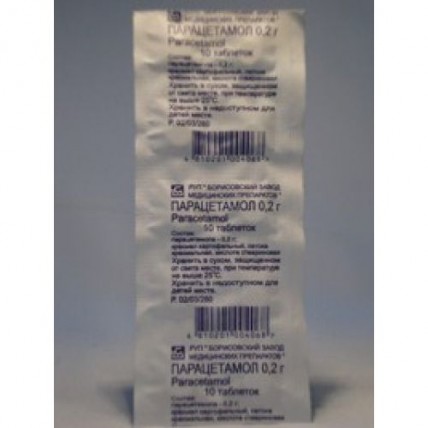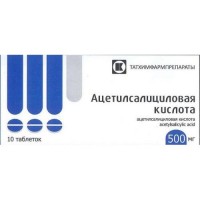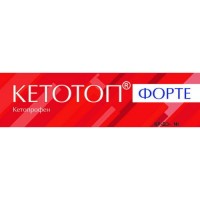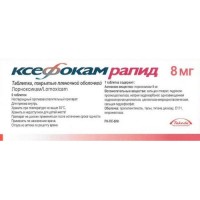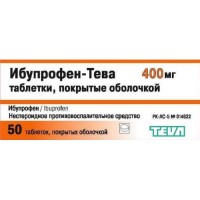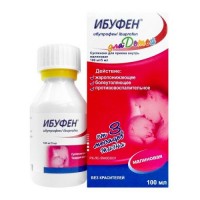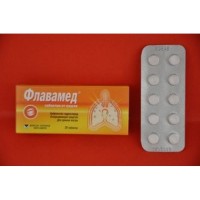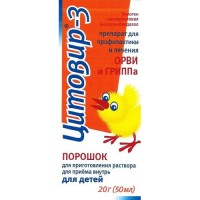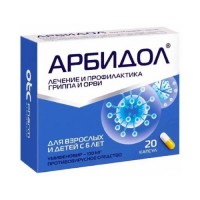Paracetamol 200mg (10 tablets)
- $1.70
The instruction for medical use
of medicine
Paracetamol
A trade name
Paracetamol
the International unlicensed
name Paracetamol Dosage Form
of the Tablet of 200 mg
Structure
One tablet contains
active agent paracetamol of 200 mg,
excipients: povidone, sodium of a kroskarmelloz, stearic acid, potato starch.
The description
of the Tablet of color, white or white with a creamy shade, ploskotsilindrichesky, with risky and a facet
Pharmacotherapeutic group
Analgetics. Other analgetics-antipyretics. Anilides. Paracetamol
the ATX N02BE01 Code
the Pharmacological
Pharmacokinetics Later properties of intake is quickly absorbed mainly in a small intestine, generally by passive transport. After single use in a dose of 500 mg the maximum concentration in plasma is reached in 0.5 2 h and makes about 16 mkg/ml then gradually going down reaches level 11 12 of mkg/ml in 6 h after reception. At repeated administration of medicine its pharmacokinetics does not change. Cumulation of medicine is not noted.
In plasma about 10 15% of medicine are in the state connected with proteins. Well gets through gistogematichesky barriers, being evenly distributed on bodies and fabrics (except for fatty tissue). Passes through a blood-brain barrier, a placenta, comes to breast milk (less than 1% of the accepted dose).
The volume of distribution (Vd) is 0.95 l/kg.
It is metabolized in a liver on three independent ways: 1) conjugation with glucuronic acid (about 50%) with formation of inactive metabolites, 2) conjugation with sulfates (about 30%) with formation of inactive metabolites, 3) hydroxylation by the system of P450 cytochrome with formation of an active intermediate metabolite N-acetyl-benzoiminokhinona (N-ABI about 17%). N-ABI contacts further glutathione and paracetamol-merkaptopurata with the participation of Mercaptopurinum and cysteine is exposed to an inactivation with education. At a lack of N-ABI glutathione can block the fermental systems of hepatocytes and cause their necrosis. At premature children, newborns and children up to 10 years the main metabolite of paracetamol is paracetamol-sulfate, at children 12 years the main metabolite of paracetamol glucuronide are more senior.
The semi-elimination period (T1/2) paracetamol is 2 3 h. Children have it slightly less, at newborns, older persons and patients with an abnormal liver function - slightly more. 30.5 - 58.5% in the form of a glucuronide, 17.5 - 33.9% in the form of sulfate, 4,5 6,1% in a look paracetamol-merkaptopurata, 0.4 - 5.9% in a look paracetamol-cysteine and 3.5 - 4.5% in not changed look are removed by kidneys with urine. It is removed in the form of metabolites with urine.
The pharmacodynamics
Paracetamol has analgeziruyushchy and febrifugal effect.
The mechanism of action is connected with inhibition of activity of cyclooxygenase I and II of types (TsOG-I and TsOG-II). Reactions of an arachidonic cascade of synthesis of eicosanoids are as a result blocked and formation of prostaglandins PgE2, PgF2a, their endoperoxides is broken.
Paracetamol has soothing effect, raises an excitation threshold of the painful centers of a thalamus. At the same time reduces activity of the thermoadjusting center of a hypothalamus, influence on it of endogenous pyrogens, strengthens a thermolysis. It is effective at a pain syndrome of weak and average intensity, fever of infectious genesis. It is used as analgetic and febrifugal, first of all, at persons with contraindications to intake of other non-steroidal anti-inflammatory drugs: patients with bronchial asthma, peptic ulcer, children with viral infections.
Medicine is deprived of anti-inflammatory action and has no antiagregantny effect. It is caused by its inactivation in the inflammation center under the influence of peroxide of oxygen and free radicals who are much formed in the inflammation center. Thus, in an inflammation zone cyclooxygenase remains protected from effect of paracetamol and the anti-inflammatory effect does not develop.
Paracetamol can be used at treatment of a pain syndrome at patients with disturbances of work of a coagulant system of blood (hemorrhagic diathesis, coagulopathies).
Indications
- a moderate pain syndrome, (including a headache, migraine, neuralgia, a toothache, a sore throat, pain in an osteoarthrosis)
- a feverish syndrome in acute infectious, infectious and inflammatory diseases.
In 1-2 h after meal (reception right after food leads to an action approach delay) to wash down a route of administration and doses For intake with a large amount of liquid. This dosage form is not applied at children 6 years are younger.
Children of 6-12 years: 200 - 400 mg (1 - 2 tablets) each 6 hours, the maximum daily dose of 1500 mg (weight is up to 30 kg) or 2000 mg (the weight is up to 40 kg). Frequency rate of appointment 3-4 times a day.
The maximum duration of treatment at use as analgetic and febrifuge no more than 3 days. Do not exceed the specified dose. In case of overdose immediately see a doctor even if you feel well.
Side effects
- allergic reactions, skin rash, a small tortoiseshell, a Quincke's disease, an anaphylaxis, Stephens-Johnson's syndrome
- hepatotoxic action at long use
- nausea, pain in epigastriums
- hemolytic and aplastic anemia, thrombocytopenia, an agranulocytosis, a pancytopenia, a methemoglobinemia
- nephrotoxic action in the form of an aseptic pyuria, interstitial nephrite, papillary necrosis
- lowering of arterial pressure, a hypoglycemia, dispnoe, a vasculitis.
Contraindications
- hypersensitivity to paracetamol silt to other components of drug
- deficit glyukozo-6-fosfatdegidrogenazy
- a renal and liver failure
- blood diseases
- pregnancy and the period of a lactation
- children's age up to 6 years.
Medicinal interactions
At simultaneous use with P450 cytochrome inductors (Phenytoinum, alcohol, barbiturates, rifampicin, phenylbutazone, tricyclic antidepressants, the combined oral contraceptives) the products of a hydroxylated toxic metabolite of N-ABI and risk of hepatotoxic action of paracetamol increase.
Alcohol also strengthens toxic effect of paracetamol on a pancreas, a liver.
At simultaneous use with P450 cytochrome inhibitors (Cimetidinum, omeprazolum, makrolidny antibiotics) the risk of gepatotoksichny effect of paracetamol decreases.
At a concomitant use with holestiraminy, Cimetidinum, omeprazolum the speed of absorption of paracetamol decreases. Paracetamol is admissible to be used not earlier than one hour after use of a holesteramin, not earlier than two hours after use of Cimetidinum, omeprazolum.
Paracetamol strengthens action of the means oppressing the central nervous system, exponentiates gematotoksichesky effect of chloramphenicol, weakens efficiency of uricosuric means (Sulfinpyrazonum).
At simultaneous use with myotropic spasmolysants (Drotaverinum, a papaverine, pitofenon) and m-holinoblokatorami (fenpiveriny bromide, Platyphyllinum, atropine), paracetamol absorption delay, owing to gastric emptying delay is observed.
At simultaneous use with pro-kinetic means (Metoclopramidum), erythromycin observes paracetamol absorption acceleration, owing to gastric emptying acceleration.
Barbiturates weaken febrifugal effect of paracetamol.
The anticoagulating effect of warfarin and other coumarins can be increased at prolonged regular use of paracetamol at patients with the increased risk of bleeding. Single doses do not render essential anticoagulating effect.
Simultaneous use with other drugs containing paracetamol is not recommended.
Special instructions
This dosage form is not intended for use for children 6 years are younger.
Influence on laboratory indicators. During treatment by paracetamol increase in level of glucose in blood plasma and distortion of results of definition of a glycemic profile is possible.
Pregnancy and period of a lactation.
Use of paracetamol during pregnancy and in the period of a lactation contraindicated. In need of use of paracetamol in the period of a lactation it is necessary to separate the child from a breast for the entire period of treatment.
The feature of influence of medicine on ability to run motor transport or potentially dangerous mechanisms
does not affect ability to control of motor transport or potentially dangerous mechanisms.
The overdose
Arises at intake of paracetamol in a dose over 10 g/days (or children have more than 140 mg/kg/days). At patients with alcoholism, hepatitis the toxic effect of paracetamol can be shown even at its use in a dose of 2,5‑4,0 g/days.
Symptoms: allocate 3 stages of development of intoxication.
the 1st stage (12 24 hour) is characterized by the dispepsichesky phenomena, symptoms of irritation of digestive tract, nausea, vomiting, perspiration.
the 2nd stage (2 ‑ 3 day) is characterized by nausea, vomiting, increase in level of transaminases, bilirubin, increase in the prothrombin ratio up to 2,0 2,5.
the 3rd stage (3 5 day) is observed at 20% of persons with intoxication, characterized by the deep progressing necrosis of hepatocytes, nausea, pernicious vomiting, jaundice, sharp increase in transaminases, bilirubin, increase in the prothrombin ratio more than 2.5. There are symptoms of a liver failure, a hypoglycemia, encephalopathy, a stupor, a renal failure and a myocardial dystrophy.
Treatment: medicine cancellation, gastric lavage with activated carbon and prescribing of salt laxatives for prevention of absorption of medicine in a stomach and intestines. Intravenously begin administration of glucose (5 10% solution of 200,400 ml). Enter specific antidote - N-Acetylcysteinum (restores reserves of glutathione and eliminates its deficit, at the same time the toxic metabolite of paracetamol is neutralized). 20% apply solution of N-Acetylcysteinum intravenously and inside: the first dose of 140 mg/kg (0.7 ml/kg), then on 70 mg/kg (0.35 ml/kg). In total enter 17 doses. The most effective is the treatment begun in the first 10 hours after development of intoxication. If from the moment of intoxication there passed more than 36 hours treatment is inefficient. At increase in the prothrombin ratio more than 1.5 apply K1 vitamin (phytomenadionum) of 1 10 mg, at increase in the prothrombin ratio more than 3.0 it is necessary to begin intravenous administration of native plasma or a concentrate of factors of coagulation (1 2 units). At treatment of intoxication carrying out an artificial diuresis, a hemodialysis is contraindicated. It is inadmissible to use antihistamines and glucocorticosteroids.
A form of release and packing
On 10 tablets in planimetric bezjyacheykovy packing from the material combined on a paper and cardboard basis.
Planimetric bezjyacheykovy packings together with the corresponding number of instructions for medical use in the state and Russian languages in group packing.
To Store storage conditions in the dry, protected from light place, at a temperature not higher than 25 wasps.
To store out of children's reach!
3 years
not to apply a period of storage after expiry date.
Prescription status
Without prescription
the Open joint stock company Producer the Borisovsky plant of medications, Republic of Belarus, Minsk Region, Borisov, Chapayev St., 64/27,
ph. / fax 8-(10375177) 744280.
The owner of the registration certificate
Open joint stock company the Borisovsky plant of medications, Republic of Belarus
.
To develop the Address of the organization accepting in the territory of the Republic of Kazakhstan claims from consumers on quality of products (goods) Open joint stock company the Borisovsky plant of medications, Republic of Belarus, Minsk Region, Borisov, Chapayev St., 64/27, ph. / fax 8-(10375177) 744280, the e-mail address of market@borimed.com
of medicine
Paracetamol
A trade name
Paracetamol
the International unlicensed
name Paracetamol Dosage Form
of the Tablet of 200 mg
Structure
One tablet contains
active agent paracetamol of 200 mg,
excipients: povidone, sodium of a kroskarmelloz, stearic acid, potato starch.
The description
of the Tablet of color, white or white with a creamy shade, ploskotsilindrichesky, with risky and a facet
Pharmacotherapeutic group
Analgetics. Other analgetics-antipyretics. Anilides. Paracetamol
the ATX N02BE01 Code
the Pharmacological
Pharmacokinetics Later properties of intake is quickly absorbed mainly in a small intestine, generally by passive transport. After single use in a dose of 500 mg the maximum concentration in plasma is reached in 0.5 2 h and makes about 16 mkg/ml then gradually going down reaches level 11 12 of mkg/ml in 6 h after reception. At repeated administration of medicine its pharmacokinetics does not change. Cumulation of medicine is not noted.
In plasma about 10 15% of medicine are in the state connected with proteins. Well gets through gistogematichesky barriers, being evenly distributed on bodies and fabrics (except for fatty tissue). Passes through a blood-brain barrier, a placenta, comes to breast milk (less than 1% of the accepted dose).
The volume of distribution (Vd) is 0.95 l/kg.
It is metabolized in a liver on three independent ways: 1) conjugation with glucuronic acid (about 50%) with formation of inactive metabolites, 2) conjugation with sulfates (about 30%) with formation of inactive metabolites, 3) hydroxylation by the system of P450 cytochrome with formation of an active intermediate metabolite N-acetyl-benzoiminokhinona (N-ABI about 17%). N-ABI contacts further glutathione and paracetamol-merkaptopurata with the participation of Mercaptopurinum and cysteine is exposed to an inactivation with education. At a lack of N-ABI glutathione can block the fermental systems of hepatocytes and cause their necrosis. At premature children, newborns and children up to 10 years the main metabolite of paracetamol is paracetamol-sulfate, at children 12 years the main metabolite of paracetamol glucuronide are more senior.
The semi-elimination period (T1/2) paracetamol is 2 3 h. Children have it slightly less, at newborns, older persons and patients with an abnormal liver function - slightly more. 30.5 - 58.5% in the form of a glucuronide, 17.5 - 33.9% in the form of sulfate, 4,5 6,1% in a look paracetamol-merkaptopurata, 0.4 - 5.9% in a look paracetamol-cysteine and 3.5 - 4.5% in not changed look are removed by kidneys with urine. It is removed in the form of metabolites with urine.
The pharmacodynamics
Paracetamol has analgeziruyushchy and febrifugal effect.
The mechanism of action is connected with inhibition of activity of cyclooxygenase I and II of types (TsOG-I and TsOG-II). Reactions of an arachidonic cascade of synthesis of eicosanoids are as a result blocked and formation of prostaglandins PgE2, PgF2a, their endoperoxides is broken.
Paracetamol has soothing effect, raises an excitation threshold of the painful centers of a thalamus. At the same time reduces activity of the thermoadjusting center of a hypothalamus, influence on it of endogenous pyrogens, strengthens a thermolysis. It is effective at a pain syndrome of weak and average intensity, fever of infectious genesis. It is used as analgetic and febrifugal, first of all, at persons with contraindications to intake of other non-steroidal anti-inflammatory drugs: patients with bronchial asthma, peptic ulcer, children with viral infections.
Medicine is deprived of anti-inflammatory action and has no antiagregantny effect. It is caused by its inactivation in the inflammation center under the influence of peroxide of oxygen and free radicals who are much formed in the inflammation center. Thus, in an inflammation zone cyclooxygenase remains protected from effect of paracetamol and the anti-inflammatory effect does not develop.
Paracetamol can be used at treatment of a pain syndrome at patients with disturbances of work of a coagulant system of blood (hemorrhagic diathesis, coagulopathies).
Indications
- a moderate pain syndrome, (including a headache, migraine, neuralgia, a toothache, a sore throat, pain in an osteoarthrosis)
- a feverish syndrome in acute infectious, infectious and inflammatory diseases.
In 1-2 h after meal (reception right after food leads to an action approach delay) to wash down a route of administration and doses For intake with a large amount of liquid. This dosage form is not applied at children 6 years are younger.
Children of 6-12 years: 200 - 400 mg (1 - 2 tablets) each 6 hours, the maximum daily dose of 1500 mg (weight is up to 30 kg) or 2000 mg (the weight is up to 40 kg). Frequency rate of appointment 3-4 times a day.
The maximum duration of treatment at use as analgetic and febrifuge no more than 3 days. Do not exceed the specified dose. In case of overdose immediately see a doctor even if you feel well.
Side effects
- allergic reactions, skin rash, a small tortoiseshell, a Quincke's disease, an anaphylaxis, Stephens-Johnson's syndrome
- hepatotoxic action at long use
- nausea, pain in epigastriums
- hemolytic and aplastic anemia, thrombocytopenia, an agranulocytosis, a pancytopenia, a methemoglobinemia
- nephrotoxic action in the form of an aseptic pyuria, interstitial nephrite, papillary necrosis
- lowering of arterial pressure, a hypoglycemia, dispnoe, a vasculitis.
Contraindications
- hypersensitivity to paracetamol silt to other components of drug
- deficit glyukozo-6-fosfatdegidrogenazy
- a renal and liver failure
- blood diseases
- pregnancy and the period of a lactation
- children's age up to 6 years.
Medicinal interactions
At simultaneous use with P450 cytochrome inductors (Phenytoinum, alcohol, barbiturates, rifampicin, phenylbutazone, tricyclic antidepressants, the combined oral contraceptives) the products of a hydroxylated toxic metabolite of N-ABI and risk of hepatotoxic action of paracetamol increase.
Alcohol also strengthens toxic effect of paracetamol on a pancreas, a liver.
At simultaneous use with P450 cytochrome inhibitors (Cimetidinum, omeprazolum, makrolidny antibiotics) the risk of gepatotoksichny effect of paracetamol decreases.
At a concomitant use with holestiraminy, Cimetidinum, omeprazolum the speed of absorption of paracetamol decreases. Paracetamol is admissible to be used not earlier than one hour after use of a holesteramin, not earlier than two hours after use of Cimetidinum, omeprazolum.
Paracetamol strengthens action of the means oppressing the central nervous system, exponentiates gematotoksichesky effect of chloramphenicol, weakens efficiency of uricosuric means (Sulfinpyrazonum).
At simultaneous use with myotropic spasmolysants (Drotaverinum, a papaverine, pitofenon) and m-holinoblokatorami (fenpiveriny bromide, Platyphyllinum, atropine), paracetamol absorption delay, owing to gastric emptying delay is observed.
At simultaneous use with pro-kinetic means (Metoclopramidum), erythromycin observes paracetamol absorption acceleration, owing to gastric emptying acceleration.
Barbiturates weaken febrifugal effect of paracetamol.
The anticoagulating effect of warfarin and other coumarins can be increased at prolonged regular use of paracetamol at patients with the increased risk of bleeding. Single doses do not render essential anticoagulating effect.
Simultaneous use with other drugs containing paracetamol is not recommended.
Special instructions
This dosage form is not intended for use for children 6 years are younger.
Influence on laboratory indicators. During treatment by paracetamol increase in level of glucose in blood plasma and distortion of results of definition of a glycemic profile is possible.
Pregnancy and period of a lactation.
Use of paracetamol during pregnancy and in the period of a lactation contraindicated. In need of use of paracetamol in the period of a lactation it is necessary to separate the child from a breast for the entire period of treatment.
The feature of influence of medicine on ability to run motor transport or potentially dangerous mechanisms
does not affect ability to control of motor transport or potentially dangerous mechanisms.
The overdose
Arises at intake of paracetamol in a dose over 10 g/days (or children have more than 140 mg/kg/days). At patients with alcoholism, hepatitis the toxic effect of paracetamol can be shown even at its use in a dose of 2,5‑4,0 g/days.
Symptoms: allocate 3 stages of development of intoxication.
the 1st stage (12 24 hour) is characterized by the dispepsichesky phenomena, symptoms of irritation of digestive tract, nausea, vomiting, perspiration.
the 2nd stage (2 ‑ 3 day) is characterized by nausea, vomiting, increase in level of transaminases, bilirubin, increase in the prothrombin ratio up to 2,0 2,5.
the 3rd stage (3 5 day) is observed at 20% of persons with intoxication, characterized by the deep progressing necrosis of hepatocytes, nausea, pernicious vomiting, jaundice, sharp increase in transaminases, bilirubin, increase in the prothrombin ratio more than 2.5. There are symptoms of a liver failure, a hypoglycemia, encephalopathy, a stupor, a renal failure and a myocardial dystrophy.
Treatment: medicine cancellation, gastric lavage with activated carbon and prescribing of salt laxatives for prevention of absorption of medicine in a stomach and intestines. Intravenously begin administration of glucose (5 10% solution of 200,400 ml). Enter specific antidote - N-Acetylcysteinum (restores reserves of glutathione and eliminates its deficit, at the same time the toxic metabolite of paracetamol is neutralized). 20% apply solution of N-Acetylcysteinum intravenously and inside: the first dose of 140 mg/kg (0.7 ml/kg), then on 70 mg/kg (0.35 ml/kg). In total enter 17 doses. The most effective is the treatment begun in the first 10 hours after development of intoxication. If from the moment of intoxication there passed more than 36 hours treatment is inefficient. At increase in the prothrombin ratio more than 1.5 apply K1 vitamin (phytomenadionum) of 1 10 mg, at increase in the prothrombin ratio more than 3.0 it is necessary to begin intravenous administration of native plasma or a concentrate of factors of coagulation (1 2 units). At treatment of intoxication carrying out an artificial diuresis, a hemodialysis is contraindicated. It is inadmissible to use antihistamines and glucocorticosteroids.
A form of release and packing
On 10 tablets in planimetric bezjyacheykovy packing from the material combined on a paper and cardboard basis.
Planimetric bezjyacheykovy packings together with the corresponding number of instructions for medical use in the state and Russian languages in group packing.
To Store storage conditions in the dry, protected from light place, at a temperature not higher than 25 wasps.
To store out of children's reach!
3 years
not to apply a period of storage after expiry date.
Prescription status
Without prescription
the Open joint stock company Producer the Borisovsky plant of medications, Republic of Belarus, Minsk Region, Borisov, Chapayev St., 64/27,
ph. / fax 8-(10375177) 744280.
The owner of the registration certificate
Open joint stock company the Borisovsky plant of medications, Republic of Belarus
.
To develop the Address of the organization accepting in the territory of the Republic of Kazakhstan claims from consumers on quality of products (goods) Open joint stock company the Borisovsky plant of medications, Republic of Belarus, Minsk Region, Borisov, Chapayev St., 64/27, ph. / fax 8-(10375177) 744280, the e-mail address of market@borimed.com
